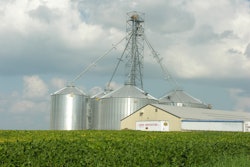Grain transportation involves much more than moving commodities from Point A to Point B. To make efficient transportation happen, many logistical intricacies must synchronize; however, it’s no secret that the foundation of our nation’s transportation delivery system — our infrastructure — is in need of special attention. As international markets catch up with our ability to handle and export grain, capital investments need to be made to keep the United States competitive in the global marketplace in order to sustain the health of our economy in the future.
In 2009, agriculture and its related industries contributed $540 billion (4.5%) to the U.S. GDP; and, according to the USDA, the total agriculture exports averaged $82.2 billion from 2005 to 2008. In 2009, ag exports were forecasted to exceed imports by $15 billion.
“As the population grows, I have no doubt farmers will produce the crops to feed the world,” says Cornel Martin, president and CEO, Waterways Council, Inc. “However, if we don’t pay attention to our transportation infrastructure, the heartland of America will not be able to move the grain to feed the world. It’s important that we focus on this now so we’re ready for the demand of the future.”
Historically, the United States has boasted the most efficient transportation system in the world, but can we maintain this advantage moving forward?
Ken Eriksen, senior vice president, informa economics, says: “We have had this power, but we also have looming pockets of problems. There are challenges we face as competition is stepping up to fill that gap, and our competitive advantage is eroding. As a nation, we must decide if we’re going to stay ahead, keep pace or fall behind.”
Every level of government sees the urgency for this investment in capacity and a better cooperation between the modes, says Ken Casavant, director of the Transportation Research Group (TRG) at Washington State University.
“Everyone agrees progress needs to be made in the advancement of waterways and rural ground transportation,” Casavant reports. “And the common theme in every discussion of the topic is ‘Where the hell does the money come from?’ ”
While politicians ponder this question, industry stakeholders are making strides toward improving the mechanisms which fund long-term infrastructure investments for the nation’s waterways.
The contribution of waterways
Waterway transportation is a lot more important to agriculture than a lot of people give it credit for, says Bruce Lambert, executive director, Institute for Trade and Transportation Studies. Barges are the most fuel-efficient, environmentally friendly way to move grain across our country; and it’s long been recognized the majority of our New-Deal-era locks and dams are in various states of disrepair.
The fear, of course, is that a catastrophic failure would shut down a key waterway for an extended period of time. Such a delay — and the related costs of unloading product and securing alternative modes of transportation for such a detour — would destroy the cost-efficiency profitable grain trade relies upon.
“The rivers are a busy interstate highway system,” Steve Jones, navigation manager, Army Corps of Engineers’ Mississippi Valley division, explains. “A 30-day closure on the upper Mississippi would have a massive impact on the [grain] industry.”
One of the corps’ high priorities is modernizing the single-chambered locks and dams of the Upper Mississippi and Illinois Rivers. Modernization would entail the construction of new, larger lock chambers adjacent to the existing structure to increase capacity. As it stands, tows have to break in half to get through the outdated 600-foot-locks — an inefficiency in itself. New locks are 1,200 feet long, allowing a whole tow to go through at one time. The new lock chambers will allow the old 600-foot chambers to serve as auxiliary chambers; thereby providing an alternate route should the main chamber fail. Without these new structures, a lock failure at any site would cease movement throughout the system.
Planning for the future
Funding deficits have long plagued the corps.
“Funds are being spent as fast as they’re coming in, but we’re not able to efficiently fund the projects that are already under construction,” Jones says. “Any new construction, such as the modernization of the upper Mississippi, is being delayed until such funds become adequate — and at this rate it would be 10 or 20 years from now before anything would get started. [Construction] isn’t sitting in limbo, it’s more like it’s limping along.”
While the stimulus package’s “shovel ready” order did not give the corps the ability to take on extensive rehabilitation, this funding was used to take smaller projects off the growing list and invest in the components should a failure occur.
“We may not be able to prevent a lock failure, but it’s not a catastrophe if you can repair the failure quickly,” Jones says. For example, stimulus dollars funded the fabrication of critical spare parts and replacement gates.
Critics of the current administration point to President Obama’s Fiscal Year 11 budget as a potential road block to waterway improvements. While President Obama’s FY 11 budget request does propose a slight reduction in the corps civil works funding ($4.939 billion or 3.77% less than 2010), it is not as drastic as anticipated.
“We fully support the President’s goals of investing in America’s infrastructure and doubling exports over the next five years,” says James Walker, navigation branch chief, operations division, Army Corps of Engineers. “However, accomplishing these goals will likely require investing more, not less, in transportation infrastructure such as inland navigation.”
Some suggest cuts hover around 10%; however, as points out when comparing apples to apples — President Obama’s FY 10 budget against the FY 11 budget — a different story emerges, as Congress historically restores a large percentage of this funding through earmarks during the appropriations process.
“We did see a reduction in the navigation funding, but it might not be as large as many folks might have thought it would be,” Walker says. “One of the challenges is that many people want to compare the FY 10 appropriations to the FY 11 budget, which can be a bit of a distortion. For those who want to see more put into it and seek to talk about Draconian, it’s a matter of how they’re trying to view the half a glass of water. It’s not like anyone has their facts wrong; it’s how they’re choosing to compare things.”
According to the Waterways Council, the FY 11 budget taps into the Inland Waterways Trust Fund for $82.4 million in matching funds for inland navigation construction and major rehabilitation — which would ultimately provide new project investments of $158.1 million, 1.7% less than last year’s request.
“The [Inland Waterway Trust Fund] is deficient, making it impossible to carry on our modernization at this time,” Jones says. Once funds are available, modernization of the upper Mississippi will start with locks on the southern end of the system and work its way up the river.
Waterway reform a top priority
Despite, the obstacles — financing and otherwise — progress is being made.
The Waterways Council, Inc. and the corps have worked closely to create a 20-year comprehensive capital development plan for the inland waterways with hopes to move the plan through Congress and have it adopted into legislation. The goals of the plan are to prioritize projects on the rivers; to bring reform to how projects are delivered; and to develop an improved funding mechanism to meet the priority need of the system.
Today, the corps decides which projects get funding on a project-by-project basis, with interests driven by competition between the various corps districts; the plan proposes taking a prioritization approach across the entire inland waterway system as opposed to relying on which navigation project has the most political muscle to secure its annual funding.
Meanwhile, the Office of Management and Budget (OMB) has significant influence over funding allocation, and distributes moneys on a “piecemeal basis” in areas that do not necessarily align in the appropriate proportions to the scope and need of the project.
“The federal government allocates a little money to this project, and a little money to that project — that’s why these projects are taking so long to build — the money runs out and no real progress is being made,” Martin says. “For example, the Olmsted project, started back in 1991, was supposed to be completed in eight years; and is still under construction. By the time it’s completed, it will have been under construction for 24 to 26 years in part because projects are funded with a piecemeal approach.”
Every year, the Inland Waterways Trust Fund struggles — even with 50/50 federal match — to fund existing projects, and unable to support the start of new ones.
“We have $3.7 billion worth of projects currently under construction,” Martin notes. “We have another $4.3 billion in projects that are authorized, but are not yet under construction. When you combine those two categories, we need $8 billion to complete the projects that are authorized and under construction, and authorized and not yet under construction. At $160 million a year, we’ll never get there.”
To paint a picture of the current situation with new construction and major rehabilitations consider this: only seven projects across the entire system will be completed in the next 20 years; under the new plan, more than 25 projects will be completed on the inland waterways system by 2030.
“Under the current mechanism of funding projects, we’re not getting a whole lot done,” Martin says. “The plan would change the way the corps manages and delivers on projects to bring more money efficiencies into the system and allow us to build projects more quickly, on time and on budget.”
The barge industry already pays a 20-cents/gallon fuel tax. This tax revenue goes into the Inland Waterways Trust Fund, and is matched by the federal government for use in new construction and major rehabilitation of the inland waterway. Under the plan, an increase of 6 to 9 cents/gallon would be imposed.
“We just don’t have enough money to meet the needs of the system, so the capital development plan that’s been put together will increase the diesel fuel tax paid by the tug and barge industry; and thereby, provide more money to the Trust Fund to build more projects,” Martin says.
Combining a condition assessment with the calculated economic return, the new plan identifies criteria for assessing the condition of each individual lock and dam based on the structural need and its economic impact — i.e., the volume and value of the cargo that moves through the system — to ensure funds are focused on the areas with the greatest need.
In December, the Inland Waterways Users Board endorsed recommendations, and they instructed the team to finalize the report. Meanwhile, several major maritime organizations — Waterways Council, American Waterways Operators, National Waterways Conference — and several commodities groups (e.g., National Corn Growers Association) have unanimously endorsed the plan.
“The major stakeholders are all lining up behind the plan,” Martin says. “Hopefully there will be a broad base of support from the constituency groups when the users board submits the final report to Congress, and it gets that kind of support in Congress,” Martin says. “We’re optimistic.”
Eriksen gives this final thought regarding the importance of a high-functioning intermodal system: “The value of grain is zero until you introduce transportation into the equation. The value of agricultural commodities is derived by a number of people in the whole supply logistics chain working to make it efficient. It’s not just the railroad operator, the barge operator or the corps — it starts with the grain companies — ranging from the multinationals or to your local grain house who have made the necessary investment to efficiently handle and to pass on product to the next mode of transportation.” ¦

















